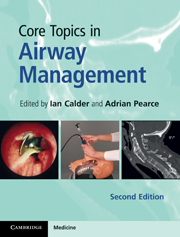Book contents
- Core Topics in Airway Management
- Core Topics in Airway Management
- Copyright page
- Contents
- Contributors
- Preface to the second edition – Calder and Pearce
- Section 1 Basic science
- Section 2 Clinical
- Section 3 Specialties
- Chapter 20 The airway in obstetrics
- Chapter 21 The paediatric airway
- Chapter 22 Bariatrics
- Chapter 23 Maxillofacial surgery
- Chapter 24 Dental anaesthesia
- Chapter 25 ENT surgery
- Chapter 26 Airway management in cervical spine disease
- Chapter 27 Thoracic anaesthesia
- Chapter 28 Airway management in the ICU
- Chapter 29 Airway management with limited resources
- Section 4 Ethics and the law
- Section 5 Examination questions
- Index
Chapter 26 - Airway management in cervical spine disease
from Section 3 - Specialties
Published online by Cambridge University Press: 10 January 2011
- Core Topics in Airway Management
- Core Topics in Airway Management
- Copyright page
- Contents
- Contributors
- Preface to the second edition – Calder and Pearce
- Section 1 Basic science
- Section 2 Clinical
- Section 3 Specialties
- Chapter 20 The airway in obstetrics
- Chapter 21 The paediatric airway
- Chapter 22 Bariatrics
- Chapter 23 Maxillofacial surgery
- Chapter 24 Dental anaesthesia
- Chapter 25 ENT surgery
- Chapter 26 Airway management in cervical spine disease
- Chapter 27 Thoracic anaesthesia
- Chapter 28 Airway management in the ICU
- Chapter 29 Airway management with limited resources
- Section 4 Ethics and the law
- Section 5 Examination questions
- Index
Summary
Keywords
- Type
- Chapter
- Information
- Core Topics in Airway Management , pp. 244 - 254Publisher: Cambridge University PressPrint publication year: 2010
- 1
- Cited by

